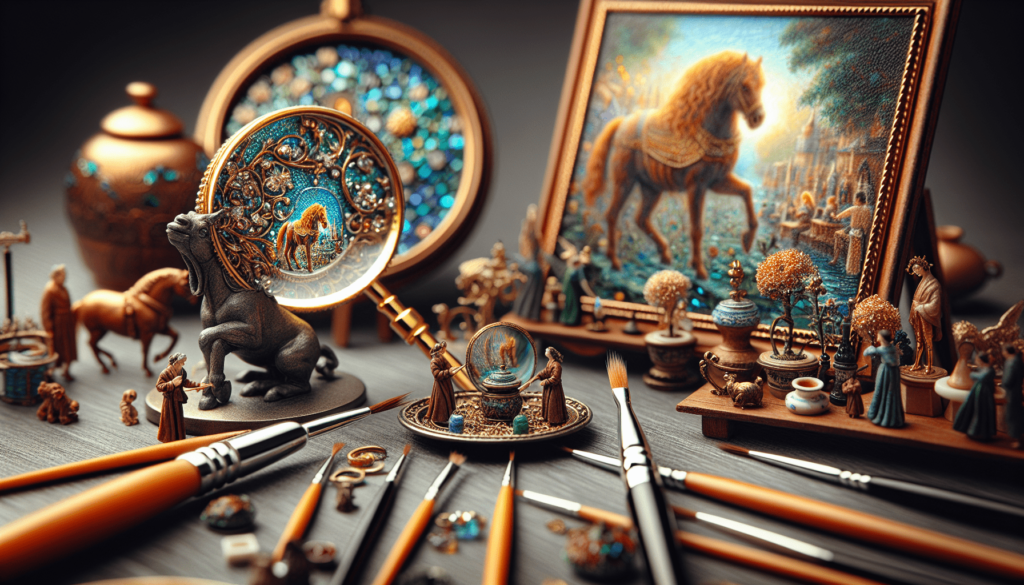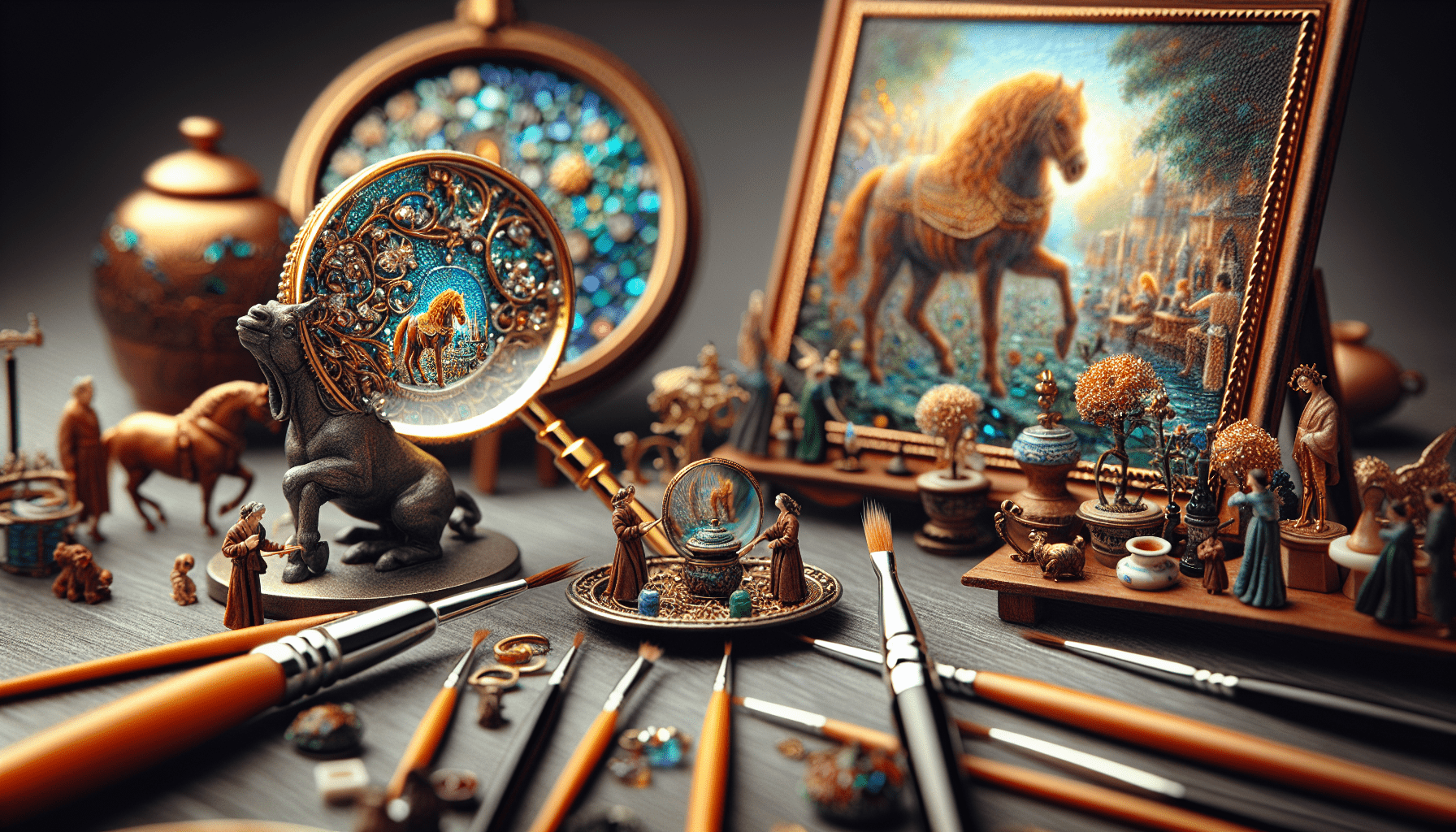In this article, you will find valuable tips and techniques on preserving and caring for miniature artworks. Whether you are a collector or an artist, it is crucial to ensure the longevity and beauty of these delicate creations. From handling and storage to cleaning and display, I will guide you through the necessary steps to maintain the charm and intricacy of your precious miniature artworks. So, grab your magnifying glass and let’s dive into the world of preserving these tiny treasures!

Choosing the Right Display Method
Use a shadow box
When it comes to displaying your miniature artworks, a shadow box can be a great option. This method allows you to showcase your pieces while protecting them from dust and potential damage. By placing your artwork in a shadow box, you create a safe and visually appealing display that allows viewers to appreciate the intricate details of the miniatures.
Consider a display case
Another display option to consider is a display case. Display cases are transparent and often made of glass or acrylic, providing an unobstructed view of the artwork while keeping it protected. The case can be placed on a shelf or table, allowing you to enjoy and share your collection while minimizing the risk of accidental damage.
Use a stand or easel
If you prefer to display your miniature artworks individually, using a stand or easel can be an effective solution. These display methods allow you to showcase each piece while keeping them upright and secure. Stands and easels come in various sizes and materials, so you can choose the one that best suits your collection’s needs and aesthetic.
Maintaining the Proper Environment
Control temperature and humidity
Creating a stable environment for your miniature artworks is crucial for their preservation. Extreme temperature fluctuations and high humidity levels can cause damage to delicate materials. It is best to store your collection in an area with controlled temperature and humidity, such as a room with a consistent climate or in a specialized storage facility.
Avoid direct sunlight
Sunlight can be incredibly damaging to artworks, especially miniatures. Prolonged exposure to direct sunlight can cause fading, discoloration, and even deterioration of the materials. Place your display or storage area away from windows or use UV-filtering curtains or blinds to block out harmful rays.
Keep away from moisture and dust
Moisture and dust can have detrimental effects on miniatures, affecting the overall condition and quality of the artwork. To avoid moisture damage, store your collection in a dry area and use dehumidifiers if necessary. Regularly dust your display or storage area and consider using a specially designed cover to protect your miniatures from dust particles.
Handling with Care
Use clean, dry hands
When handling your miniature artworks, it is important to ensure that your hands are clean and dry. Oils, dirt, and moisture on your hands can transfer onto the artwork, potentially causing damage over time. Before touching any miniatures, wash your hands thoroughly and pat them dry to minimize the risk of contamination.
Avoid touching the artwork directly
Miniature artworks are often delicate and intricate, and touching them directly can lead to accidental damage or wear over time. If possible, handle the miniatures by their bases or use a pair of clean, lint-free gloves to provide an extra layer of protection. By avoiding direct contact, you can help preserve the original condition of each piece.
Handle with gloves if necessary
In certain circumstances, it may be necessary to handle your miniatures with gloves. For highly sensitive materials or objects with delicate surfaces, wearing gloves can minimize the risk of oils or fingerprints damaging the artwork. When selecting gloves, opt for those made from materials that won’t leave residues or friction marks, such as nitrile or cotton.
Cleaning Techniques
Use a soft, clean brush
Regular cleaning is essential to maintain the appearance and condition of your miniature artworks. When removing dust or debris, use a soft brush with fine bristles. Gently brush the surface of the artwork in one direction, taking care not to apply too much pressure. A clean, soft brush will effectively remove particles without causing damage.
Avoid using liquid cleaners
While it can be tempting to use liquid cleaners, they can be too harsh for miniature artworks and may cause irreversible damage. Liquid cleaners can seep into the materials, leading to discoloration, warping, or even dissolution of pigments or adhesives. Stick to dry cleaning methods like brushing or using compressed air to ensure the safety of your miniatures.
Consider professional cleaning if needed
If you are unsure about cleaning your miniature artworks or if they require more specialized care, it is best to seek the assistance of a professional art conservator or preservation expert. These professionals have the knowledge and expertise to handle delicate pieces, clean them using appropriate methods, and ensure their long-term preservation.
Framing Options
Choose a frame that protects the artwork
When it comes to framing your miniature artworks, selecting the right frame is crucial. Opt for a frame that provides proper support and protection for the artwork, preventing it from coming into direct contact with the glass or acrylic. A frame with a depth of at least one inch will allow adequate spacing between the artwork and the glazing, minimizing the risk of damage.
Use acid-free mats and backing
To further protect your miniatures when framing, use acid-free mats and backing. Acid-free materials prevent the transfer of harmful chemicals onto the artwork, preserving its condition and integrity. Acid-free matting also adds a professional touch to the presentation, enhancing the visual appeal of your miniatures.
Consider UV-protective glazing
UV-protective glazing is a valuable addition when framing miniature artworks, especially if they will be displayed in an area exposed to natural or artificial light. UV rays can cause significant damage over time, leading to fading, discoloration, and degradation of the artwork. UV-protective glazing filters out harmful rays, preserving your miniatures for years to come.
Storage Guidelines
Wrap in acid-free tissue paper
When storing your miniature artworks, take the necessary steps to protect them from potential damage. Wrap each piece individually in acid-free tissue paper to prevent scratches and minimize the risk of moisture buildup. This simple yet effective method will help maintain the condition of your collection during periods of storage.
Store in a temperature-controlled environment
Creating an optimal storage environment is essential for the long-term preservation of your miniature artworks. Aim to store your collection in an area with controlled temperature and humidity levels. Extremes in temperature or humidity can lead to warping, cracking, or deterioration of materials. Maintain a stable environment to ensure the longevity of your miniatures.
Keep away from potential damage
When choosing a storage location for your miniatures, consider the potential risks and hazards. Keep your collection away from areas prone to moisture, such as basements or attics, as well as places where it may be at risk of accidental damage, such as high traffic areas or near household items that could cause harm. By storing your miniatures in a safe and secure location, you can minimize the risk of potential harm.

Disaster Preparedness
Have an emergency plan in place
Preparing for unexpected events is crucial to protect your miniature artworks. Develop an emergency plan that includes detailed instructions on how to safeguard your collection in the event of a natural disaster or any other unforeseen circumstances. Take the time to educate yourself and others in your household about the necessary steps to protect your miniatures during emergencies.
Consider insurance coverage
Accidents or disasters can happen despite our best efforts to prevent them. To safeguard your investment, consider obtaining insurance coverage specifically for your valuable miniature artworks. Consult with an insurance professional who specializes in art insurance to ensure you have adequate coverage for potential damages or losses.
Protect against natural disasters
Depending on your location, you may face specific natural disaster risks, such as earthquakes, floods, or hurricanes. Take proactive steps to protect your miniature artworks from such disasters. Securely fasten shelving units or display cases to walls or floors, use earthquake putty or museum wax to secure items, and have a plan in place for quickly moving your collection to a safe location if necessary.
Avoiding Environmental Hazards
Keep away from smoke and pollutants
Smoke and pollutants can cause significant damage to miniature artworks, degrading their appearance and compromising their integrity. Keep your collection away from areas where smoking occurs or where pollutants are present, such as fireplaces, kitchens, or garages. Maintaining a smoke-free and clean environment will help ensure the longevity of your miniatures.
Avoid exposure to pests and insects
Pests and insects can wreak havoc on your miniature artworks, causing irreparable damage. Take preventive measures by regularly inspecting your display or storage area for signs of infestation and using appropriate pest control methods if necessary. Consider using mesh screens or covers to further protect your collection from potential intruders.
Properly seal the artwork
To minimize the risk of exposure to environmental hazards, properly seal your miniature artworks when necessary. This is especially important for artworks made from delicate materials or those susceptible to moisture damage. Consulting an art preservation expert can help you determine the best sealing method for each piece in your collection.
Artwork Documentation
Create an inventory of your collection
Keeping track of your miniature artworks is essential for their preservation and management. Create an inventory listing each piece in your collection, including relevant details such as title, artist, dimensions, and any other pertinent information. This inventory will not only serve as a record of your collection but also assist in insurance claims or potential resale in the future.
Document artist information and provenance
For valuable miniature artworks, documenting artist information and provenance is vital. Research and record the background and history of each piece, including the artist’s name, date of creation, and any significant exhibitions or previous owners. This information adds value to your collection and provides valuable context for future generations.
Store related documents safely
In addition to documenting artist information and provenance, it is important to store any related documents or paperwork safely. This includes certificates of authenticity, exhibition catalogs, and receipts of purchase. Keeping these documents organized and protected ensures that they are readily available and enhances the overall value of your miniature artworks.
Professional Advice
Consult art conservators or preservation experts
When in doubt or if you have specific concerns about the preservation of your miniature artworks, seek guidance from art conservators or preservation experts. These professionals have extensive knowledge and experience in the field and can provide valuable insights and recommendations tailored to your specific collection.
Attend workshops or seminars on artwork care
To further expand your knowledge and skills in artwork preservation, consider attending workshops, seminars, or online classes dedicated to this subject. These educational opportunities can provide you with expert advice, practical techniques, and the latest advancements in art preservation, empowering you to better care for your miniature artworks.
Follow recommendations from professionals
Once you have sought professional advice or attended educational events, it is essential to follow the recommendations provided. Art conservators and preservation experts are well-versed in the best practices for caring for miniature artworks, and their advice should be taken seriously. Implementing their recommendations will help ensure the longevity and quality of your cherished collection.
Caring for miniature artworks requires attention to detail, proper handling, and providing a suitable environment for their preservation. By following these comprehensive guidelines, you can enjoy and protect your miniature collection for years to come. Remember, the key to preserving the beauty and integrity of miniatures lies in proactive care, regular maintenance, and seeking professional advice when needed.

Leave a Reply